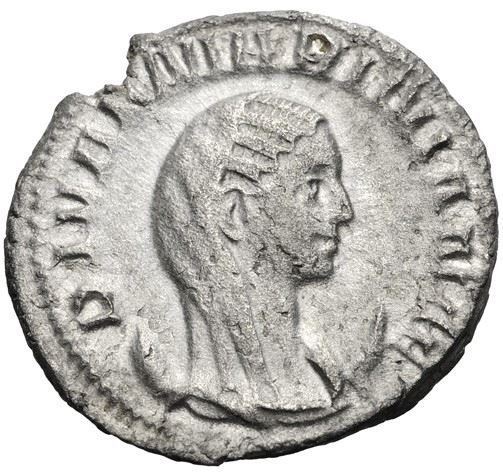Egnatia Mariniana was probably the wife of Roman Emperor Valerian and mother of Emperor Gallienus.
Several coins bearing the legend DIVAE MARINIANAE date back to the beginning of the reign of Valerian and Gallienus.
Given the practice of deifying the wives who died before their husbands' assumption of the Principate, it is possible that Mariniana died before Valerian took power in AD 253.
Several coins bearing the legend DIVAE MARINIANAE date back to the beginning of the reign of Valerian and Gallienus.
Given the practice of deifying the wives who died before their husbands' assumption of the Principate, it is possible that Mariniana died before Valerian took power in AD 253.

(1)
Mariniana

An
AR
Antoninianus
struck ~AD 257
in
Rome
Obverse: DIVAE MARINIANAE, Diademed, veiled and draped bust r., on crescent
Reverse: CONSECRATIO, Peacock standing facing, head l., spreading plumage
Diameter:
20 mm
Die Orientation: 12 H
Weight: 1.93 g
Die Orientation: 12 H
Weight: 1.93 g
No notes for this coin
RIC V 3; RSC 2
(2)
Mariniana
_3.jpg)
An
AR
Antoninianus
struck AD 253-254
in
Rome
Obverse: DIVAE MARINIANAE, diademed, veiled and draped bust right
Reverse: CONSECRATIO, peacock standing facing, tail spread in splendour
Diameter:
21 mm
Die Orientation: 7 H
Weight: 4.05 g
Die Orientation: 7 H
Weight: 4.05 g
Peacocks were kept and bred in large flocks by the Romans, both for pleasure and for profit. In Roman myth and cult the peacock was sacred to the goddess Juno, and became the badge of empresses and other ladies of the imperial house as well as a regular feature on the imperial coinage. The peacock’s tail, circular like the vault of heaven when spread and jewelled as with stars, made the bird a natural symbol of the sky to which the dead ascend and hence of apotheosis and immortality. This particular coin was struck by Valerian I before he ascended the throne, and commemorates the death of his wife Mariniana.
RIC 3; Sear 10067
